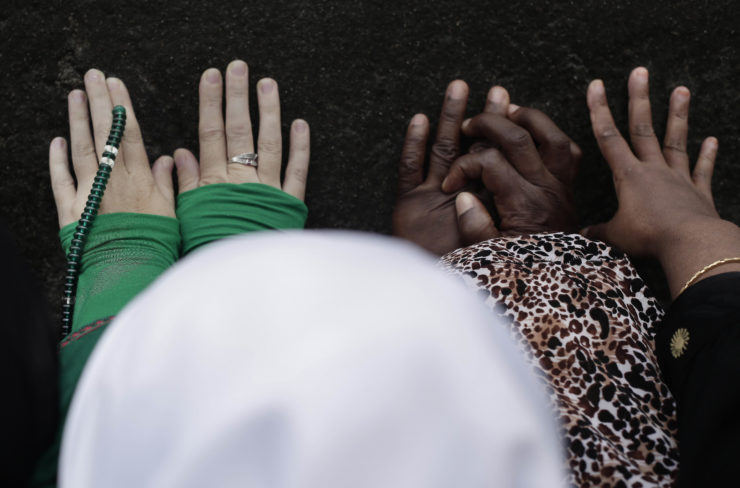
Women touch the Kaaba, Islam's holiest shrine, for blessing at the Grand Mosque in Makkah at the Hajj annual pilgrimage.
Want an end-of-summer beach read that’ll turn heads faster than a Burkini ban? Consider Asma Lamrabet’s book, Women in the Qur’an: An Emancipatory Reading, which has just been translated into English from the French. Not only is the subject matter provocative, but the book cover seems vibrant and modern — a Warhol riff, with funky, saturated colors of smiling Muslim women, some wearing the hijab, some not.
The book by Lamrabet, a Moroccan scholar, is riding a burgeoning wave of feminist Muslim literature that aims to take back our narrative. As Muslim women, our voices seem to have been scrubbed from the conversation. But our stories, and influence, are central to many Qur’anic verses.
How’s this for a cool example? Over the weekend, my favorite feminist symbol repeated itself, as it has for 14 centuries and counting: Millions of Muslims walked in the footsteps of one woman—literally.
For the yearly pilgrimage known as Hajj, the devout follow the path of a woman named Hajer. The story goes that she frantically walked between two mounts, Al Safa and Al Marwa, seven times to find water for her child.

A female worshiper at the Grand Mosque in the Muslim holy city of Makkah, Saudi Arabia, for the annual Hajj pilgrimage.
Yes, that means that everyone — men included — imitated a woman as part of the duties of Hajj (and of Umrah, a smaller pilgrimage that can be done at any time of the year). And unlike some aspects of everyday life in the Muslim world, men and women must walk shoulder to shoulder, unsegregated, during their pilgrimage to Saudi Arabia’s mountainous holy city of Makkah, the official spelling of the city many know as Mecca.
The Qur’an is “the primary and eternal source of the Islamic vision of life and human destiny,” Lamrabet writes in the book’s intro. She asks a tough question: Is it religion, as a system of values, that created the restrictions often associated with the oppression of women? Or is it something created by society, reformulating the teachings of the religious texts to suit whomever is in power at the moment? After all, women in the early days of Islam were seen as active and lively members of society.
But wait, a whole book about women in the Qur’an—were there really that many? Yes.
Growing up in Saudi Arabia, I was taught to be modest about my accomplishments as a woman. From what I recall, we often didn’t get to read a lot about other Muslim women in history or literature courses at my school. Except in religion class. We had plenty of women to discuss there.
In fact, surat al Nisa, The Women, is the second-longest surah, or chapter, in the Qur’an. That chapter weaves together many vignettes, and ties the seemingly unrelated stories together to form a cohesive collective narrative. Because “mankind” also includes women, one could argue that the Qur’an speaks about, and to, both genders. The fact that the holy book dedicated a whole surah to women reveals how much it honors them.
Men didn’t get their own surah.
Over the weekend, my favorite feminist symbol repeated itself, as it has for 14 centuries and counting: Millions of Muslims walked in the footsteps of one woman.
Although many of the women mentioned throughout the Qur’an are well-known figures in history, the point of those stories is to allow for any woman or girl to identify with the stories and lessons. Moses’ mother, the Pharoah’s wife and even the Queen of Sheba all make appearances. We can tell who they are based on the context and identifying details. (Only Mary, the mother of Jesus, is mentioned by name.)
Yes, it is true that many of the women are mentioned by their relationship to men: they are daughters, mothers or wives. That would seem unfair, but many of the men are also introduced as brothers, husbands or sons.
In Lamrabet’s book, I hear echoes of my big question: When did women in Islamic interpretations become merely foolish girls or patient mothers? The women in early Islam fought battles or had entire verses dedicated to them. Somewhere along the centuries, Muslim women became stuck on the sidelines, instead of on the front lines.
I love the story of the moment that the Angel Gabriel appeared before the Prophet Muhammad. Who was the first person the prophet ran to? His first wife, Khadija. She was his boss—in and out of the house.
Khadija was a successful caravan businesswoman in Makkah, and she regularly interacted with men and women in her work. The prophet, who later became the most important man in Islam, was a penniless orphan with charm but no status. Khadija was a single mother who was twice widowed and 15 years his senior. He was 25, she was 40. Not only was Khadija often referred to as the love of his life and the person he leaned on for advice and mentorship, but she inspired many surahs.
If the prophet was attracted to a strong, feisty woman, doesn’t that mean that we Muslim women should try to be that way too?
It’s easy to see why many non-Muslims haven’t heard or seen this side of Islam. Many Muslims seem to have forgotten these parts, too. Images of frightened women in burqas and stories of honor killings frequently paint Islam as an intolerant religion—which isn’t how it necessarily looks in Lamrabet’s view, nor in mine.
That oppressed existence is sadly the reality of many, many women, but isn’t the full story. Often, those issues emerge at the hands of intolerant and insecure men who don’t follow the prophet’s example by interacting with strong women. And it is important to note that many Muslim women choose to don conservative outfits and cover-up, which is absolutely the way it should be.
Regardless of the dress, or cover, debate, Islam is full of women warriors who lived and live life fearlessly. There are many sides to each story, and this new book is just one interpretation, and a personal view. Within its pages, it is trying to shift the conversation by going back to the 1,400-year-old source, the Qur’an, instead of rephrasing watered-down interpretations from extremists.
How feminist is Islam? It depends on your understanding of the text. As the Qur’an says, we should each make it a point to open the book and read it ourselves.


